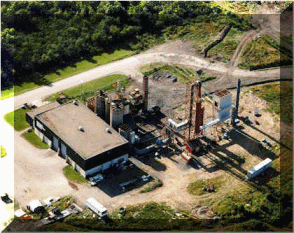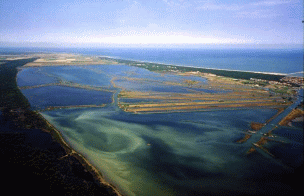Waste management and reclamation of contaminated sites
The growing pressure on natural resources and the progressive increase in the production of waste represent new challenges for our society. Waste production and management play a central role in environmental policy. The production of industrial and urban waste has exploded, with a growth rate of 4 to 5 times in the last ten years. This means that policy makers, as managers of public health and well-being, must be harsh in introducing laws which regulate waste management practices. From a modern viewpoint, waste is to be considered a lost resource and, hence, it is a manufacturing cost variable that must be optimized with both direct costs and the cost to society in mind.
Since it is not possible to avoid the
production of waste, the main objective in order of importance is to try to
reduce it to a minimum. Waste minimization
programs are emerging as priorities, with particular emphasis on the reduction
in the waste of those substances which, due to their persistence in the
environment,
bioaccumulation![]() and toxicity, once released, can be harmful to
human health and the environment over long periods. A list
of 31 priority chemicals to be eliminated can be found on the EPA web site:
and toxicity, once released, can be harmful to
human health and the environment over long periods. A list
of 31 priority chemicals to be eliminated can be found on the EPA web site:
http://www.epa.gov/epaoswer/hazwaste/minimize/chemlist.htm
The second objective
in order of importance concerns recycling and reusing waste.
Finally, the third
objective in order of importance regards treating waste in such a way to reduce
the overall mass.
The latest and least
attractive technology (albeit the most common nowadays) regarding waste
treatment is to dispose of it in
landfills![]() ,
specially designed according to the type of waste. Today, public opposition to the sitting of
new disposal facilities through fear of contamination of air, water, etc,
represents a further difficulty in guaranteeing the storage capacity of waste.
,
specially designed according to the type of waste. Today, public opposition to the sitting of
new disposal facilities through fear of contamination of air, water, etc,
represents a further difficulty in guaranteeing the storage capacity of waste.
| Fig. 1: The
municipal incinerator in Nova Scotia, Canada, where 300 tons/day of
urban solid waste is treated. This incinerator uses very advanced
technology, in terms of thermoelectric energy production efficiency and
minimization of solid and gaseous
polluting (Credit: EnerWaste Incineration System) |
 |
A classic way to reduce mass by up to 90% is incineration, which also permits energy recovery, as the heat from the emitted gases is captured through the formation of heated steam for direct use or to produce electricity.
Another waste
management strategy is
composting![]() ,
based on the biodegradation of solid materials in a medium other than soil by
means of micro-organisms. If the residue of biodegradation, or compost, is
contaminated by toxic substances, then specially-controlled landfills are
needed.
,
based on the biodegradation of solid materials in a medium other than soil by
means of micro-organisms. If the residue of biodegradation, or compost, is
contaminated by toxic substances, then specially-controlled landfills are
needed.
Unfortunately in Italy there is a growth in "ecomafia", turning "waste into
gold": 13.1 million tons of toxic waste "disappeared" in 2003 into the hands of the
Mafia, who dumped it in illegal landfills, mostly in Southern Italy, where
harmful toxic waste is buried, dumped without precautions, sometimes even just
scattered in the countryside.
It
is estimated that in the next ten years the "ecomafia" will have pocketed 132
billion euros from this business.
Up to the 1970s, when the first environmental laws came into force (the Merli Bill), it was common practice in Italy to discharge household and industrial waste directly into the nearest bodies of surface water. Even today, the huge city of Milan is still directly discharging part of its sewer system into rivers flowing into the River Po.
 |
Fig. 2:
Pialassa Baiona
(PB)
is an intertidal brackish lagoon north of Ravenna
(Italy) which covers a surface area of about 1,100 ha. PB was declared
wetland of international importance under the Ramsar Convention and is part
of the "Po Delta Park". The sedimentary compartment of the southern part has
been heavily affected by
pollution (Credit: Foto archivio Biserni, Ravenna (1998).) |
An example of bad industrial waste management in Italy is the coastal lagoon of Pialassa Baiona to the north of Ravenna, whose state of health has been under laboratory examination by the environmental science students of Ravenna University for several years. The ENICHEM petrochemical plant built in the 1950s on the banks of the Candiano Canal dumped its waste in the lagoon for at least two decades, and the history of these discharges is recorded in the sediments of the lagoon, where a disturbing presence of mercury, polycyclic aromatic hydrocarbons, PVC and polymers can be seen.
Great
scientific and technological efforts are today dedicated to the
reclamation of contaminated sites![]() , to making
them safe and bringing them up to the required quality standards. This work
regards disused industrial sites or land around industrial complexes, areas near
mines or areas where toxic waste had been dumped (old tips, etc).
, to making
them safe and bringing them up to the required quality standards. This work
regards disused industrial sites or land around industrial complexes, areas near
mines or areas where toxic waste had been dumped (old tips, etc).